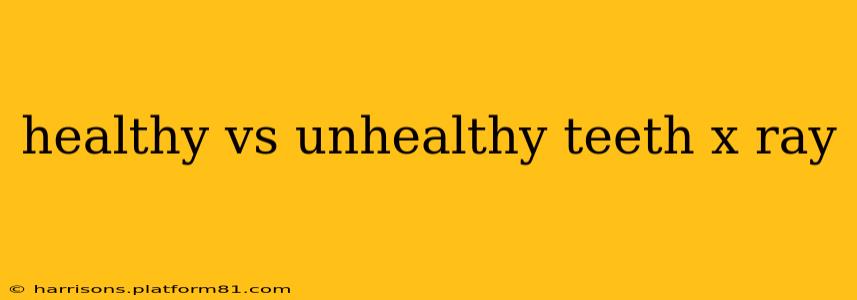Dental X-rays are essential tools for dentists to diagnose oral health issues. They provide a clear picture of what's happening beneath the surface of your teeth and gums, revealing problems invisible to the naked eye. Learning to interpret the differences between healthy and unhealthy teeth on an X-ray can empower you to better understand your own dental health and communicate effectively with your dentist.
What Does a Healthy Tooth Look Like on an X-Ray?
A healthy tooth on an X-ray will exhibit several key characteristics:
- Uniform Density: The enamel and dentin will appear as a consistent, radiopaque (white) structure. There shouldn't be any significant variations in density or color within the tooth itself.
- Intact Structure: The crown (visible part of the tooth) and root (portion embedded in the jawbone) will be complete and clearly defined. No fractures or cracks should be present.
- Proper Bone Support: The area surrounding the root (the periodontal ligament space) will be a thin, consistent radiolucent (dark) line. Sufficient bone density will be visible around the root, indicating strong support.
- Absence of Cavities: No radiolucent areas within the tooth structure itself, which would indicate decay.
Image Example: (Note: I cannot display images directly. Search "healthy tooth x-ray" on Google Images for visual examples.) Look for an image showing a consistently white tooth with a clear, thin dark line around the root, and ample surrounding bone.
What Does an Unhealthy Tooth Look Like on an X-Ray?
Several conditions can manifest differently on a dental X-ray, indicating unhealthy teeth:
Cavities (Dental Caries)
X-rays reveal cavities as radiolucent (dark) areas within the tooth structure. The size and location of the cavity will be visible, allowing the dentist to determine the extent of the damage and plan treatment accordingly. Early cavities may appear as small, indistinct dark spots, while advanced cavities can be larger and more clearly defined.
Abscesses
An abscess, an infection at the root of a tooth, often appears as a radiolucent area at the root tip. Sometimes, a bone loss around the apex of the root will also be visible.
Periodontal Disease
Periodontal disease, or gum disease, shows up in X-rays as bone loss around the teeth. The radiolucent (dark) space around the roots will be wider than normal, indicating the loss of supporting bone structure. Advanced periodontal disease may reveal significant bone loss, jeopardizing tooth stability.
Root Fractures
Root fractures can be difficult to detect on X-rays, but they may appear as a faint line running through the root. This is why a thorough clinical examination is also crucial.
Impacted Teeth
Impacted teeth, teeth that haven't fully erupted, are clearly visible on X-rays. Their position and relationship to surrounding teeth and structures can be assessed.
Image Example: (Again, search "tooth decay x-ray," "abscess x-ray," etc. on Google Images for visual examples of these unhealthy conditions.)
How Can I Tell if My Teeth Are Healthy From an X-Ray?
You shouldn't attempt to diagnose your own X-rays. Dental X-rays require professional interpretation. Your dentist is trained to identify subtle signs of disease and assess the overall health of your teeth and gums.
What if My X-Ray Shows Unhealthy Teeth?
If your X-ray shows signs of dental problems, your dentist will discuss the findings with you, explain the diagnosis, and recommend the appropriate treatment plan. This could range from simple fillings for cavities to more complex procedures like root canals or periodontal therapy.
What are the Different Types of Dental X-Rays?
Several types of dental X-rays provide different views of your teeth and surrounding structures:
- Bitewing X-rays: Show the crowns and interproximal spaces (areas between teeth) of both upper and lower teeth.
- Periapical X-rays: Show the entire tooth, including the crown and root, as well as the surrounding bone.
- Panoramic X-rays: Provide a wide view of the entire upper and lower jaws. Useful for detecting impacted teeth, cysts, and other abnormalities.
Your dentist will determine which types of X-rays are necessary based on your individual needs.
This information is for educational purposes only and should not be considered medical advice. Always consult with your dentist for any concerns about your oral health.
